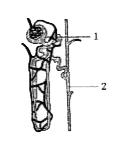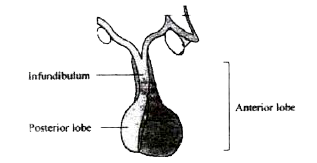In which of the following cases flux is required?
(i) In the smelting of roasted zinc blende
(ii) In the extraction of iron from haematite in the blast furnace. Explain. Mention the name of the flux with the purpose it serves where it is required.
Flux is required in the extraction of iron from haematite. Limestone (CaCO3) is used as flux. On heating, it decomposes into quicklime (CaO) and carbon dioxide.
The quicklime produced reacts at high temperature with silicious impurities of the ore to form calcium silicate as an easily fusible slag.
Topper's Solved these Questions
- GENERAL PRINCIPLES AND PROCESSES OF ISOLATION OF ELEMENTS Book:ICSEChapter:GENERAL PRINCIPLES AND PROCESSES OF ISOLATION OF ELEMENTS Exercise:EXERCISE (PART-II ( DESCRIPTIVE QUESTIONS )) (SHORT ANSWER QUESTIONS)
Explore 205 Videos
- GENERAL PRINCIPLES AND PROCESSES OF ISOLATION OF ELEMENTS Book:ICSEChapter:GENERAL PRINCIPLES AND PROCESSES OF ISOLATION OF ELEMENTS Exercise:EXERCISE (PART-II ( DESCRIPTIVE QUESTIONS )) (LONG ANSWER QUESTIONS)
Explore 53 Videos
- GENERAL PRINCIPLES AND PROCESSES OF ISOLATION OF ELEMENTS Book:ICSEChapter:GENERAL PRINCIPLES AND PROCESSES OF ISOLATION OF ELEMENTS Exercise:EXERCISE (PART-I ( OBJECTIVE QUESTIONS )) (MATCH THE FOLLOWING)
Explore 6 Videos
- ELECTROCHEMISTRYBook:ICSEChapter:ELECTROCHEMISTRYExercise:ISC EXAMINATION QUESTIONS (PART-II Numerical Problems)
Explore 19 Videos
- HALOALKANES AND HALOARENES Book:ICSEChapter:HALOALKANES AND HALOARENES Exercise:SOURCE
Explore 9 Videos
Similar Questions
Explain the role of each of the following in the extraction of metals from their ores :
(i) CO in the extraction of nickel.
(ii) Zinc in the extraction of silver.
(iii) Silica in the extraction of copper.
View SolutionThe chief ores of iron are haemalite (Fe2O3) , magnetite (Fe3O4) , limonite (FeO(OH)) and siderite (FeCO3).In the extraction of iron , oxides ores of iron, after concentration through calcination/roasting in reverberatory furnace are mixed with lime stone and coke and fed into a blast furnace. Here, the oxide is reduced to the metal.
Which of the following is obtained as a slag in the extraction of iron from haematite ore ?
View Solution
Knowledge Check
Consider the following statements :
S1: In extration of iron from haematite ore, the reduction reactions take place only in the lower temperature range in the blast furnace.
S2: Calamine in an carbonate ore of zince.
S3: The principle ore of aluminium , bauxite , usually contains silica, iron oxides and titanium oxide as impurities.
S4: Solidified copper obtained from silica lined conventor ( Bessemer converter ) has blistered appearance due to the evolution of SO2.
Which are correct statements?AI and IIBII and IIICI and IIIDII, III and IVRead the given passage and answer the questions that follows: Rhodinus, a blood-sucking bug, shows five instars before it metamorphoses into an adult. It ahs a very long head with the brain located at tip and an organ called Corpora Cardiaca (C C) behind it. The hormone that ensures the continuum of the juvenile stages is called a juvenile hormone. Behind the head is a pro - thoracic gland, which gets triggered by the Pro - Thoracico - Tropic Hormone (PTTH) to release ecdysone required for molting into an adult.

The following observations were made when the juveniles of this insect were subjected to various conditions :
1. Starved juveniles (any instar) when decapitated → remained juveniles and did not molt into adults.
2. Well-fed juveniles (any instar) when decapitated → molted into adults.
3. Starved juveniles (any instar) when partially decapitated to remove the brain cells → remained juveniles and did not molt into adults.
4. Well - fed juveniles (any instar) when partially deitated to remove the brain cells → did not molt into adults.
Which of the following conclusions can be drawn from this data ?
(i) Ecdysone hormone is produced irrespective of the level of feeding.
(ii) C C is the site of production of juvenile hormone.
(iii) PTTH is produced irrespective of the level of feeding.
(iv) Increase in juvenile hormone is an important trigger for production of PTTH.
(v) Absence of C C alone is a trigger for molting into adult form.
(vi) Well-fed larvae in absence of juvenile hotmone can molt into adults.A(i), (iii) (iv) and (v)B(ii), (iv) and (v)C(ii) and (vi)D(i) and (iv)
The chief ores of iron are haemalite (Fe2O3) , magnetite (Fe3O4) , limonite (FeO(OH)) and siderite (FeCO3).In the extraction of iron , oxides ores of iron, after concentration through calcination/roasting in reverberatory furnace are mixed with lime stone and coke and fed into a blast furnace. Here, the oxide is reduced to the metal.
Reducing species in the extractive metallurgy of iron from haematite ore is :
View SolutionName the metals which are associated with the following terms in their extraction from their ores :
(a) Bessemer's converter
(b) Blast furnace
( c) Aluminityhermic process
(d) Magnetic separation.
View SolutionMetals are extracted from their ores by a wide variety of techniques. The most common ores are oxides. Most metals are obtained by direct treatment of theirs ores with chemical agents, but the extraction of certain others require electrolysis. An example of the former type of process is the extraction of iron from its oxide, described by the following equation :
Fe2O3+3C→2Fe+3CO
The relative ease of extraction of a metal from its oxide can be estimated using the Ellingham diagram, as shown in the figure.
The diagram plots the free energies of formation of various oxides per mole of consumed oxygen as a function of absolute temperature.

Which of the following best explains why the free energy of formation of Fe2O3 becomes less negative as the temperature is increased.
View SolutionDespite the fact that aluminium is a reactive metal, it is a stable in
air as well as in water. This is due to the formation of thin layer of
oxide on the surface of aluminium metal which makes it passive for further attack. The layer is so useful, that in industry, it is purposely deposited by an electrolytic process called anodising. Reaction of aluminium with oxygen is highly exothermic and is called thermite reaction.
2Al(s)+32O2(g)→Al2O3(s)ΔfHӨ=−1670kJmol−1
This reaction finds application for welding of metal and in the metallurgical extraction of many metals from their oxides.
The limitation is that to start the reaction, high temperature is
required for which an ignition mixture is required.
Which of the following metals cannot be extracted by using Al as a reducing agent ?
View SolutionThe diagram given below is that of a structure present in a human kidney. Study the same and answer the questions that follows :

(i) Name the structure represented in the diagram.
(ii) What is the liquid entering part T called? Name two substances present in this liquid that are reabsorbed in the tubule.
(iii) What is the fluid that comes to part '2' called? Name the main nitrogenous waste in it.
(iv) Mention the three main steps involved in the formation of the fluid mentioned in (iii) above.
(v) Name the substance which may be present in the fluid part '11 if a person suffer from diabetes mellitus.
View SolutionThe diagram given below represents an endocrine gland in the human body. Study the diagram and answer the following questions :

(i) Identify the endocrine gland. Where is it located?
(ii) Why is the above gland referred to as the 'Master gland' ?
(iii) Name the hormone which in deficiency causes Diabetes Insipidus. How does this disorder differ from Diabetes Mellitus ?
(iv) Explain the term 'Hormone'.
What is the role of Tropic hormones in the human body?
(v) Which lobe of the above gland secretes:
1. Oxytocin
2. ACTH
3. Growth hormone.
View Solution